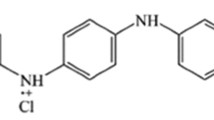Abstract
Shape-controllable polyaniline (PANI) nanostructures were synthesized using phenol or hydroquinone as morphology-control agent. Various morphologies of PANI nanostructures, such as, one-dimensional fibers, two-dimensional lamellar structures, and three-dimensional flower-like structures, were obtained through altering the mole ratio of phenol or hydroquinone to aniline. Scanning electron microscopy was applied to observe the morphologies of the products. Ultraviolet–visible absorption spectra and Fourier transform infrared spectra demonstrate that the ratio between quinoid structure and benzene structure was affected by the amount of phenol or hydroquinoid used in the synthesis process. This simple approach has opened a controllable synthesis route to fabricate advanced functional materials.






Similar content being viewed by others
References
Gordana C (2013) Recent advances in polyaniline research: polymerization mechanisms, structural aspects, properties and applications. Synth Met 177:1–47
Stejskal J, Sapurina I, Trchova M (2010) Polyaniline nanostructures and the role of aniline oligomers in their formation. Prog Polym Sci 35:1420–1481
Savas SZ, Recep T, Seckin A, Muzaffer C (2012) Polyaniline micro-rods based heterojunction solar cell: structural and photovoltaic properties. Appl Phys Lett 101:253301–253304
Amit N, Smrutiranjan PJ (2016) Comparison of polyaniline electrodeposition on carbon steel from oxalic acid and salicylate medium. Prog Org Coat 94:28–33
Recep T, Muzaffer C, Savas SZ (2015) Preparation and characterization of polyaniline microrods synthesized by using dodecylbenzene sulfonic acid and periodic acid. Turk J Chem 39:589–599
Díaz-Sánchez Jesús, Rosas-Aburto A, Vivaldo-Lima E, Hernández-Alcántara JM, Isabel GM, Humberto VT, Ordóñez LC, Pedro R, Miquel G (2017) Development and characterization of a flexible electrochromic device based on polyaniline and enzymatically synthesized poly (gallic acid). Synth Met 223:43–48
Gao H, Zhang J, Yu W, Li Y, Zhu S, Li Y, Wang T, Yang B (2010) Monolithic polyaniline/polyvinyl alcohol nanocomposite actuators with tunable stimuli-responsive properties. Sensor Actuat B-Chem 145:839–846
Li T, Qin Z, Liang B, Fei Tian F, Zhao J, Liu N, Zhu M (2015) Morphology-dependent capacitive properties of three nanostructured polyanilines through interfacial polymerization in various acidic media. Electrochim Acta 177:343–351
Canan T, Recep T, Muzaffer C (2014) Increasing the crystallite and conductivity of polypyrrole with dopant used. Ionics 20:1687–1692
Zhao Q, Chen J, Luo F, Shen L, Wang Y, Wu K, Lu M (2016) Assembly of ordered polyaniline-graphene hybrid nanomaterials based on poly(2-methoxyaniline-5-sulfonic acid) functionalized graphene Nanosheets. Synth Met 221:103–113
Verena G, Jana K, Miroslava T, Jirí B, Jan Z, Jakub P (2016) Polyaniline/polybenzimidazole blends: characterisation of its physico-chemical properties and gas separation behaviour. Eur Polym J 77:98–113
Huang J, Shabnam V, Weiller B, Kaner R (2003) Polyaniline nanofibers: facile synthesis and chemical sensors. J Am Chem Soc 125:314–315
Wang J, Yang S (1989) Morphological modification of polyaniline using polyelectrolyte template molecules. Synth Met 29:271–276
Roch Chan YK, Roussel F (2009) Toward a simple method for the fabrication of 1D or 3D nanostructures of polyaniline. Synth Met 159:2512–2518
Yu X, Fan H, Wang H, Zhao N, Zhang X, Xu J (2011) Self-assembly hierarchical micro/nanostructures of leaf-like polyaniline with 1D nanorods on 2D foliage surface. J Mater Lett 65:2724–2727
Tanon K, Montree S, Poramane C, Montakan S, Phansiri S, Patarachai S, Atiweena K, Santamon L, Pawin I, Juthaporn W, Nutthaphon P, Pichamon S, Tanut P, Jumras L (2015) High-performance supercapacitor of electrodeposited porous 3D Polyaniline nanorods on functionalized carbon fiber paper: effects of Hydrophobic and hydrophilic surfaces of conductive carbon paper substrates. Mater Today Commun 4:176–185
Zhang Z, Wei Z, Wan M (2002) Nanostructures of polyaniline doped with inorganic acids. Macromolecules 35:5937–5942
Wang X, Li Y, Deming D (2008) Sorption of pentachlorophenol on surficial sediments: the roles of metal oxides and organic materials with co-existed copper present. Chemosphere 73:1–6
Zhang X, Kolla HS, Wang X, Raja K, Manohar SK (2006) Fibrillar growth in polyaniline. Adv Funct Mater 16:1145–1152
Pillalamarri SK, Blum FD, Tokuhiro AT, Story JG, Bertino MF (2005) Radiolytic synthesis of polyaniline nanofibers: a new templateless pathway. Chem Mater 17:227–229
Anderson RE, Ostrowski AD, Gran DE, Fowler JD, Hopkins AR, Villahermosa RM (2008) Diameter-controlled synthesis of polyaniline nanofibers. Polym Bull 61:563–568
Qiang J, Yu Z, Wu H, Yun D (2008) Polyaniline nanofibers synthesized by rapid mixing polymerization. Synth Met 158:544–547
Ding S, Mao H, Zhang W (2008) Fabrication of DBSA-doped polyaniline nanorods by interfacial polymerization. Appl Polym Sci 109:2842–2847
Zhou C, Han J, Song G, Guo R (2007) Polyaniline hierarchical structures synthesized in aqueous solution: micromats of nanofibers. Macromolecules 40:7075–7078
Wang X, Li Y, Zhao Y, Liu J, Tang S, Feng W (2010) Synthesis of PANI nanostructures with various morphologies from fibers to micromats to disks doped with salicylic acid. Synth Met 160:2008–2014
Moon Gyu H, Ki Cho S, Geun OhS, Soon Im S (2002) Preparation and characterization of polyaniline nanoparticles synthesized from DBSA micellar solution. Synth Met 126:53–60
Prabhu SM, Sankaran M (2016) Defluoridation of water using dicarboxylic acids mediated chitosan-polyaniline/zirconium biopolymeric complex. Int J Biol Macromol 85:16–22
Zhang W, Ju W, Wu X, Wang Y, Wang Q, Zhou H, Wang S, Hu C (2016) Structure, stability and electrochromic properties of polyaniline film covalently bonded to indium tin oxide substrate. Appl Surf Sci 367:542–551
Zhao Y, Wang C (2016) Extremely facile synthesis of manganese dioxide-polyaniline nano-reticulation with enhanced electrochemical properties. J Alloy Compd 677:281–287
Sun Y, MacDiarmid AG, Epstein AJ (1990) Polyaniline: synthesis and characterization of pernigraniline base. J Chem Soc, Chem Commun 7:529–531
Zhang L, Wan M (2003) Self-assembly of polyaniline-from nanotubes to hollow microspheres. Adv Funct Mater 13:815–820
Acknowledgements
This work was supported by the National Natural Science Foundation of China (No. 21376178) and the Youth Innovation Foundation of Tianjin University of Science & Technology (No. 2015LG15).
Author information
Authors and Affiliations
Corresponding authors
Rights and permissions
About this article
Cite this article
Hao, J., Zhao, W., Zhang, H. et al. Controlled synthesis of PANI nanostructures using phenol and hydroquinone as morphology-control agent. Polym. Bull. 75, 2575–2585 (2018). https://doi.org/10.1007/s00289-017-2159-z
Received:
Revised:
Accepted:
Published:
Issue Date:
DOI: https://doi.org/10.1007/s00289-017-2159-z



